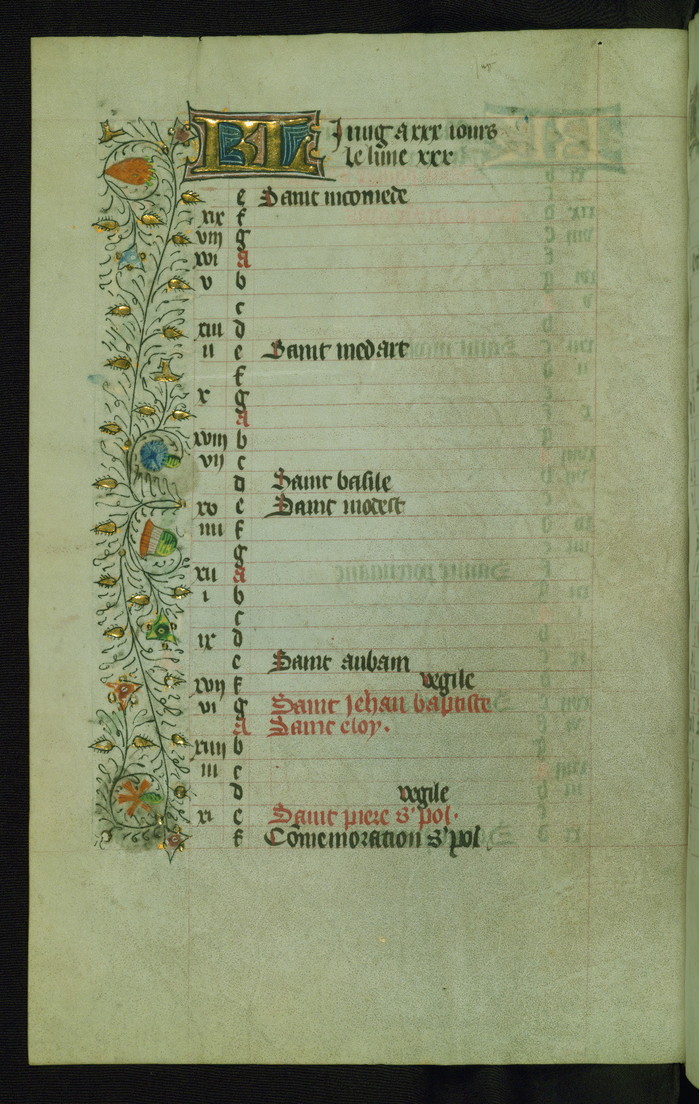Another early manuscript from the Walters Art Museum, W.37 is a early 14th C (1300-1310ish) Book made for the Use of Liege, probably for a Beguine living in Huy (Belgium, south-west of Liege). The manuscript has a series of full-page miniatures between the calendar and the Hours of the Nativity of the Virgin, and does not contain the standard Hours of the BVM.
The Calendar is rather bare, with only 160 entries in total. The entries are very accurate in content, none were unidentified and only 2 were on the wrong date, both by a single day. There are several unusual saints, mostly localized to Liege, including Count Mengold on February 8 (4244).
That is not to say that the calendar is without error, however, as there are two sorts of error present. The black entries were penned before the miniatures, and in multiple cases the miniature has over-painted the text. This is most obvious in the later months, in December(see f.8v below) the Nativity of the Virgin is missing the entire last word, due to the Labor of the Month. Additionally the red entries were done by a poor scribe, the hand is extremely shakey and inconsistant. This red-ink scribe neglected to include at least one feast, there is a Vigil for St. Laurence on August 9 (651) but no entry for the feast on the 10th.
(DB Id: 93)
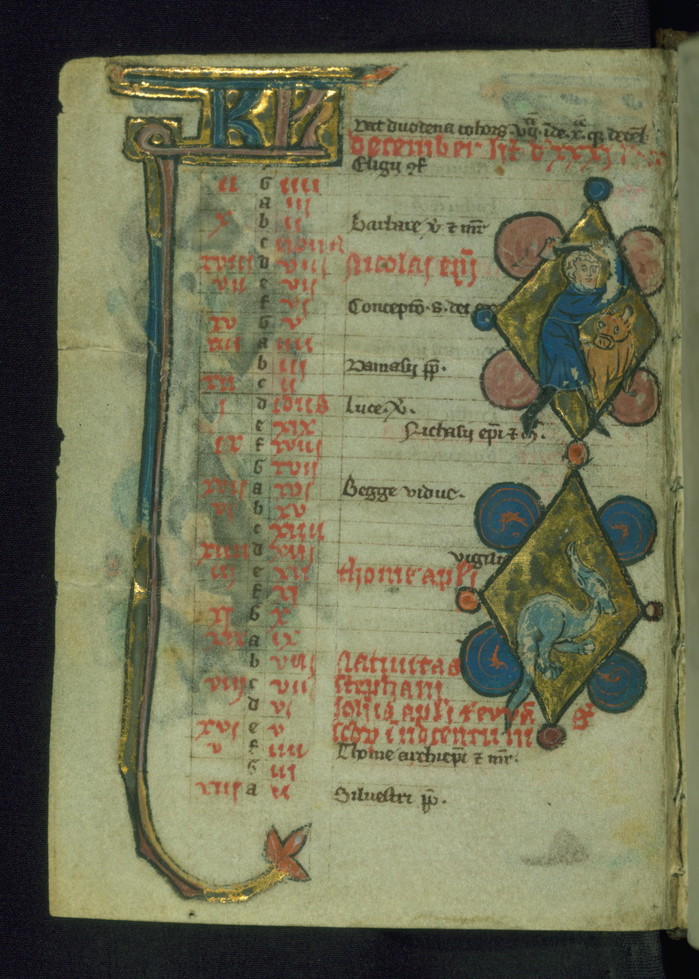
W.86 from the Walters Art Museum is an early manuscript from Arras, near Calais. It dates to the late 13th century, making it an early example. Like many 13th C Hours, it has some unusual contents, in this case a series of six miniatures depicting the Passion between the Calendar (1r-12v) and the Hours of the of the Virgin, which start with a striking full-page historiated initial on f.19r. The Calendar is also interesting both due to it being in Old French and due to the large number of errors and unidentified saints. There are 17 errors and 47 unidentified entries, or roughtly 30% of the 198 total. Some of the unidentified saints have clear readings, but have no matching known feast. Others, such as Waubort on November 15(see f.11r below), are French translations of known saints, in this case St Walburga, but still are unmatched for the date.
(DB Id: 256)
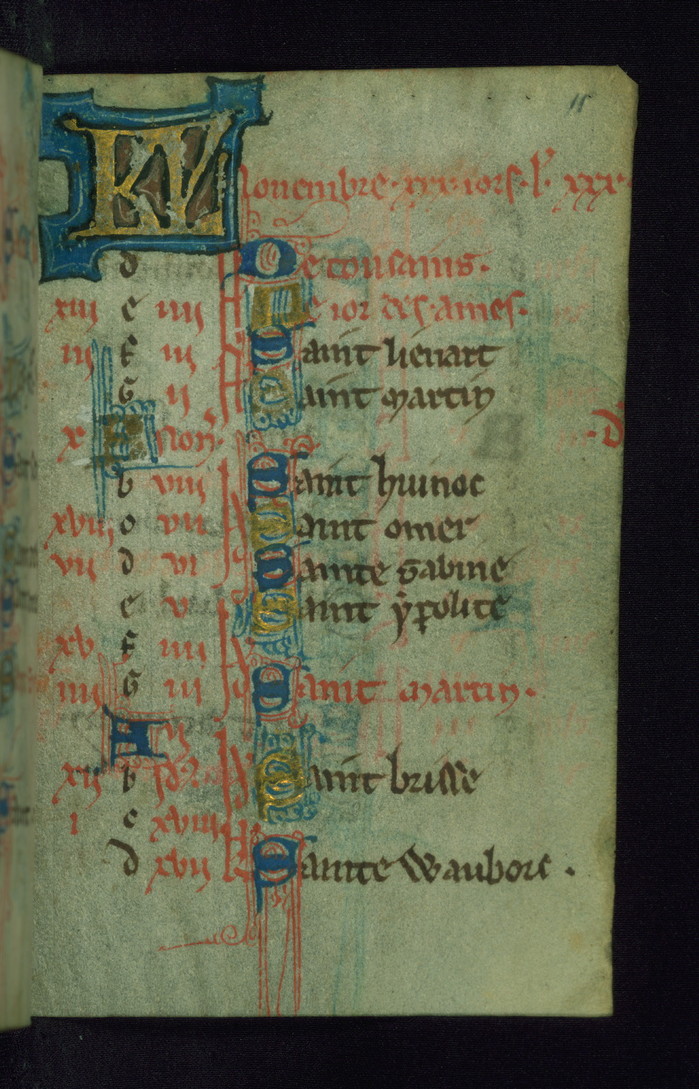
Walters Art Museum W.194 is another book from the Hainaut region of Belgium. It is attributed to between 2 and 4 illuminators, at least one working in the style of Simon Marmion (fl. 1449-1489). The calendar is pretty bare, with only 138 feasts, 41 of which are ranked red. There are not a large number of errors, 4 are identified, but it is unusual to see a high-importance feast like that of the Apostle Thomas on the wrong date.
(DB Id: 213)
Walters Art Museum W.193 is a French book of hours, with an unusual liturgical use of Cambrai, dated to roughly 1450-1460. There is evidence that the initial owner live in Mons, Hainaut (now part of Belgium). The calendar has some light decorations on the recto, an outer-border of acanthus leaves, and has 200 dates populated, though a higher-than-usual number of errors in the dating of saints. There’s also an unusual case, Saint Germain on August 8(see f.11r below) is unidentified, but ranked high. So far no “Germain” or similar name has been found for that date, but hopefully future work can identify this high-importance saint.
(DB Id: 212)
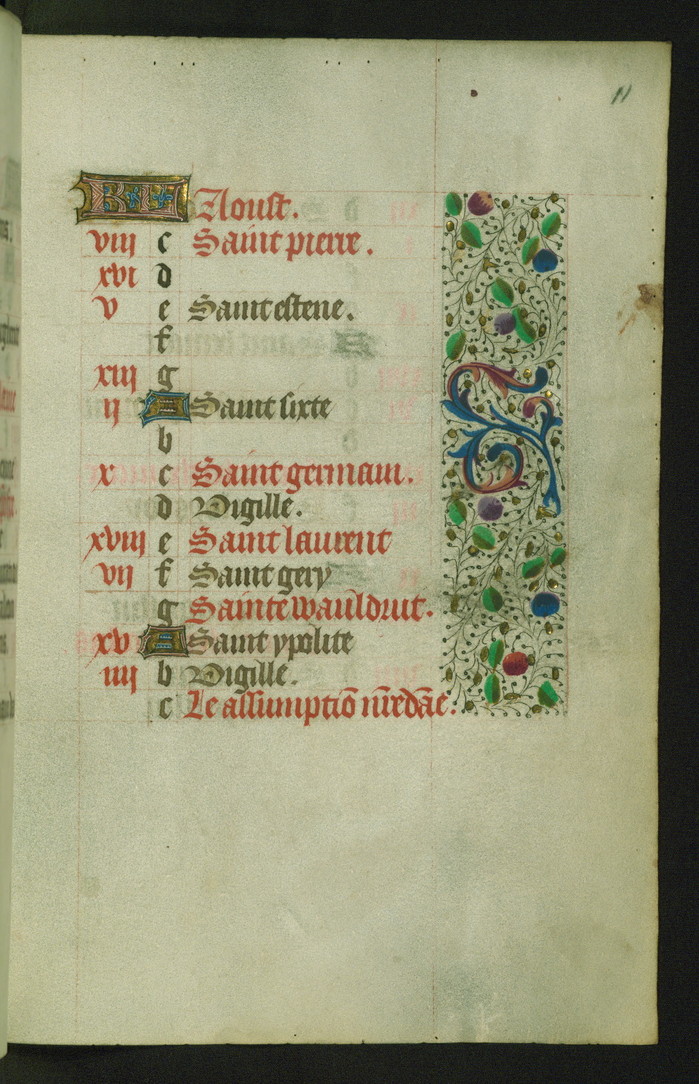
Shifted fully to the Master of the Black Prayerbook, or a follower, gives us Walters Art Museum W.190. It’s another late 15th C Flemish Book of Hours, this one somewhat difficult to localize between Bruges and Liege. It’s been rebound out of order at some point in its life, but having the digitized copy allows us to return it to a more sensible, if not demonstrably original, order.
The calendar is complete “in intent if not in execution”. A scribal error caused April to only have 29 entries, and it appears the feast for April 19 has been omitted. The saints have a very strong Bruges character, often following the unusual saints of that city. There are a few on the wrong dates, and a pair of strange errors. May 23 has “Transfigura[o] d[omi]ni”, where that day is actually the feast of the Translation, which is an unusual feast peculier to Bruges. A stranger error is September 13(see f.9r below), usually the feast of St. Philip, is here listed as “Philippi & Jacobi”. That feast is May 1, and so points to a scribal error rather than a copying error.
(DB Id: 211)
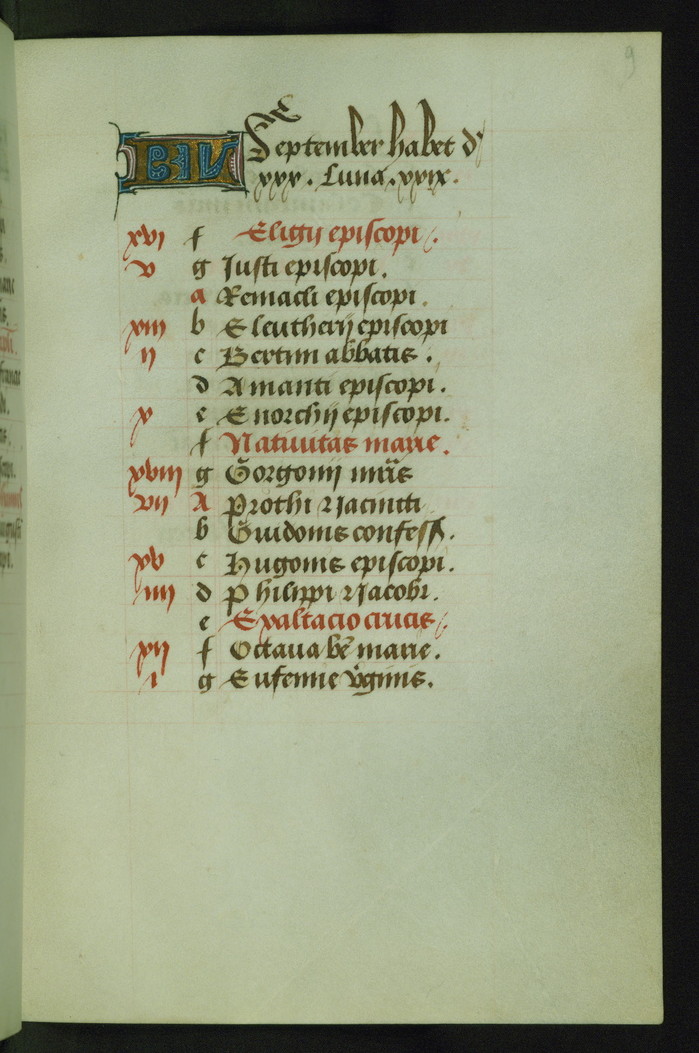
In Walters Art Museum W.189 Willem Vrelant worked with the Master of the Black Prayerbook to create the elaborate color-block foliate borders and full-page grisaille miniatures that fill the book. Even the KL at the top of each month of the calendar are carefully done in grisaille, backgrounded with brown that was hightened with a spray of gold spots.
The calendar entries are in Dutch, though the rest of the book is in Latin. There are only 124 saints in the calendar, mostly the usual ones. There are a few unusual saints, one is St. Brendan, written as “brandaris”, on May 16(see f.5v below). There are actually two Sts. Brendan on that day, and it’s unclear which is meant. Later in that month, May 22, is an unidentified St. Anthonis.
(DB Id: 210) 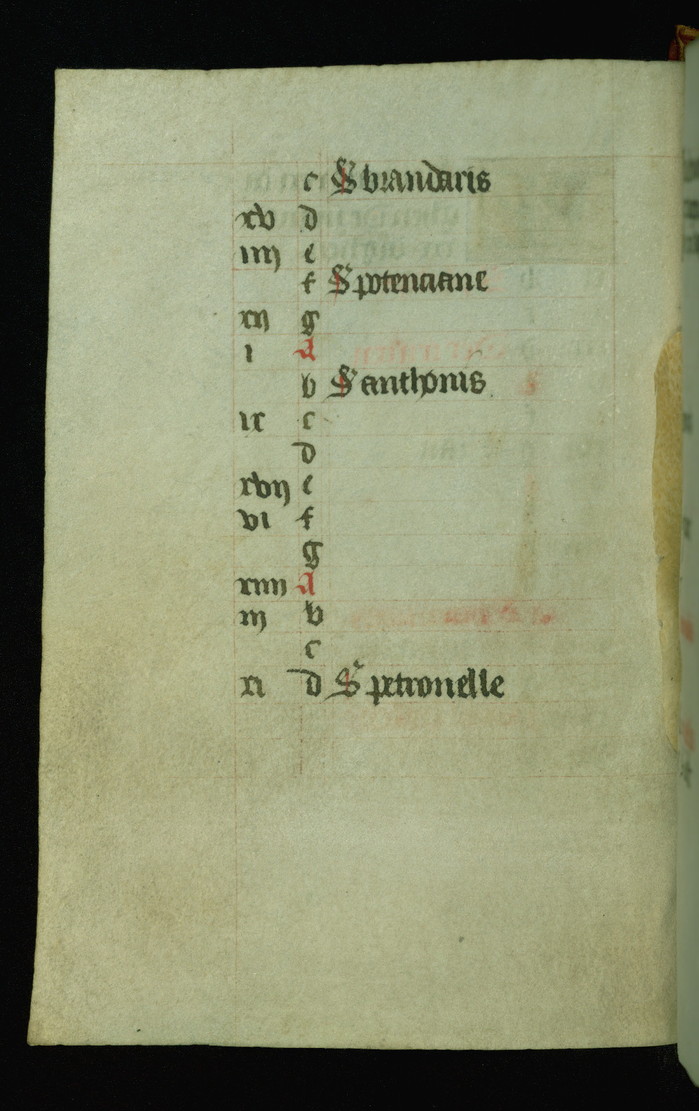
With Walters Art Museum W.186 we are back to manuscripts from the circle of Willem Vrelant. This is a lovely book, the multiple illustrations of angelic musicians are rightly famous, with, as is sadly common, a rather undecorated calendar. There’s no illumination on the calendar except the KL at top, even the space for the more decorated ‘A’ in the dominical letters is unfilled. In the dominical letters there’s also a duplicate, the G for July 15 is written at the bottom of f.7r and the top of 7v.
The most interesting bit, however, is the beginning of the month of October(see f.10r below). The usual saint for October 1, Bishop Remigius of Reims, has been pushed to October 2. Listed on October 1, in red, are Sts. Bavo, an unusual but by no means unique saint for that day often seen in Dutch and Flemish manuscripts, and St. Gaidii. The catalogue interprets this as a variant of Aegydius, but the usual day him is September 1, and I’ve found no reference to a variant date of October 1. For now I am leaving this entry untagged, hopefully another example will come along and help clarify things
(DB Id: 209)
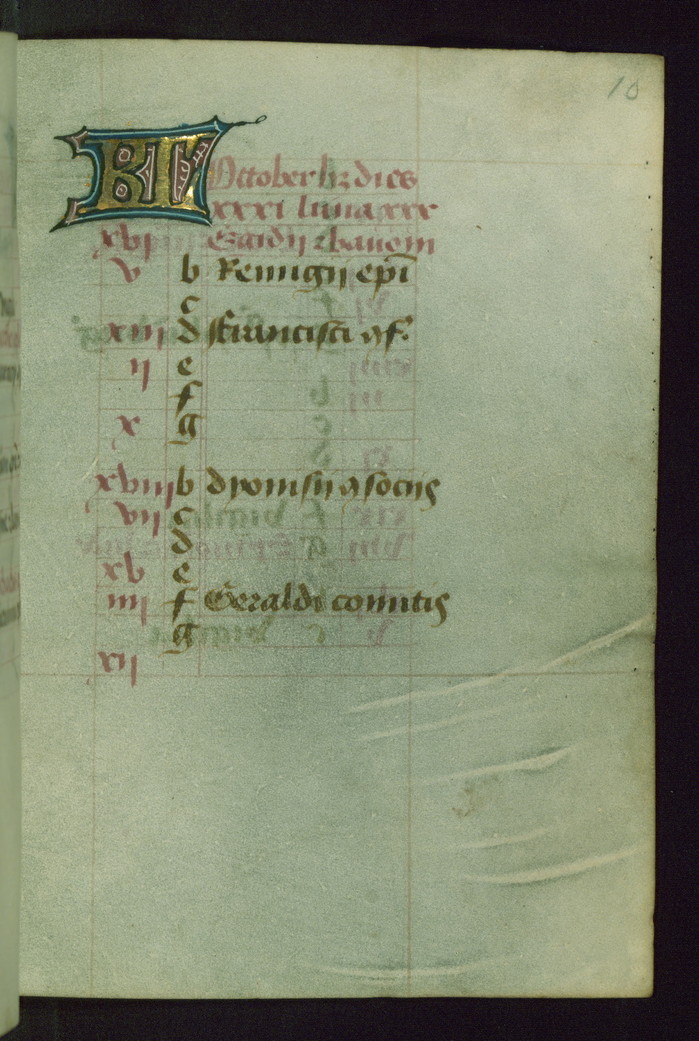
Yet another William Vrelant manuscript held at the Walters Art Museum, W.184 is a late 15th C book from Bruges. The calendar is not very decorated, but there's a bit of gold leaf on the KL at least. In the calendar there are only 120 days populated, and of those the regular 1/3 are ranked high. The saints listed are a smattering of the usual Belgian ones, though there are a few unusual ones. One that stands out is St. Cornelius (March 31, see f.5v below), which only appears in one other book, the Huth Hours (BL MS Add 38126)
(DB Id: 204)
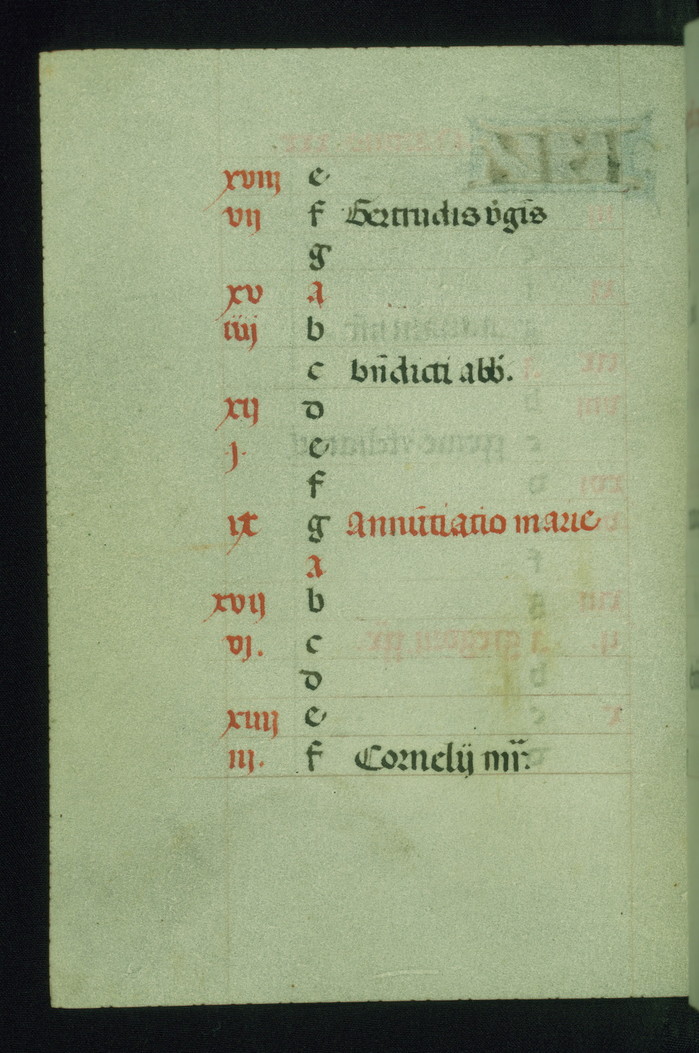
Continuing to add from the Walters Art Museum, W.183 is a late 15th C book from Bruges. The manuscript was illuminated in the circle of William Vrelant, as were Walters W.168, W.177, W.179, and W.180. The calendar is very sparse, both in terms of decoration and population. There is no border, Zodiac or labor of the month, only the bare minimum of KL at the start of the month. After the Calendar, there are lovely borders, with berries and birds, at the start of sections of the text and a profusion of full-page miniatures.
The calendar itself is rather common, about 50% full (155 saints) and of those about 1/3 high-importance feasts. There are a fair number of errors, even some of the important feasts, such as the Sunday of the Resurrection(should be March 27) or the Pope Leo the Great(should be April 11), have shifted by a day or two. I'd expect this is either scribal error in this MS, due to the low population of saints it's harder to keep registration, or an error in the source. Hopefully a larger DB of similar manuscripts will narrow the root cause.
(DB Id: 203)
W.173 is another French book from the new website of the Walters Art Museum. This one is Use of Rome, but the calendar, in French, is somewhat non-specific. With only 110 saints consisting of a smattering of Dutch, French and Fransiscans, it has not been localized. As seems to be somewhat common in French books, there are no Vigils in the first half of the year, the first being that for the Nativity of John the Baptist (June 23, see f.3v below).
(DB Id: 200)
